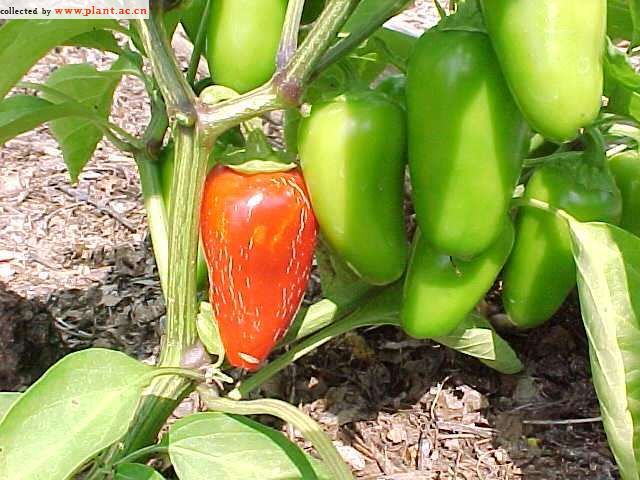Capsicum annuum (hot pepper group)Chili pepper
科:茄科
Family:Solanaceae
属:辣椒属
common name:Chili pepper
introduce:Plant Type: Herbaceous perennial
Family: Solanaceae
Missouri Native: No
Native Range: Southwestern United States, Central and S America, Caribbean
Height: 1 to 2.5 feet
Spread: 1 to 2 feet
Bloom Time: -
Bloom Color: White
Sun: Full sun (only)
Water: Medium moisture
Maintenance: Medium
General Culture:
Peppers demand warm weather and don抰 like their roots disturbed. Plant seeds in a sunny warm location in peat pots (3 seeds to a pot, thinning to 1 plant per pot) 6 to 8 weeks before transplanting into the garden after all danger of frost is past and night temperatures are consistently at or above 55 degrees F. Plant in full sun in fertile well-drained soil 18 to 24" apart in rows 18 to 24" apart. Do not permit seedlings or plants to suffer from low temperature or drought. Mulching between plants is useful. Avoid planting where peppers, tomatoes, or eggplants grew previously. All three are members of the nightshade family and are subject to similar diseases. After one or more plantings of any of these three in a particular location, carryover pathogens in the soil can infect new plants. Peppers do well as container plants, and can be maintained over longer periods with indoor wintering, providing a sufficiently sunny location is available.
Noteworthy Characteristics:
Most peppers, also known as chili peppers, can be categorized as one of three general types: sweet peppers, hot peppers or ornamental peppers. However, these categories are general at best. Some hot peppers aren抰 hot, all peppers can be highly ornamental, many ornamental peppers are hot, etc. -- and none of these categories necessarily mirror botanical nomenclature distinctions. Peppers were one of the earliest plants cultivated in the New World. Archeological evidence suggests that peppers were used as food ingredients in Peru more than 8,000 years ago. Columbus mistakenly applied the label 憄epper?to the plant he found growing in Caribbean gardens, likely confusing it with the highly prized but botanically unrelated black pepper. Within 100 years, peppers had spread around the world and today constitute the defining ingredient in traditional cuisines worldwide, including countries such as Italy, Thailand, Hungary, India, Spain, China and Holland. Botanically, most cultivated peppers today are Capsicum annuum (most common), C. frutescens (tabasco), C. chinense (habanero), or crosses within and among these various species.
Potential pests include aphids, white flies, cutworms, pepper maggots, and Colorado potato beetles. Diseases include Verticillium wilt and mosaic virus.
Uses:
All peppers can be highly ornamental with deep green leaves and fruit of a wide variety of shapes, sizes and colors. Colors may include green, red, yellow, chocolate, orange, lilac, purple, ivory and mahogany. As fruits gradually ripen, several colors can be found on a plant simultaneously.
